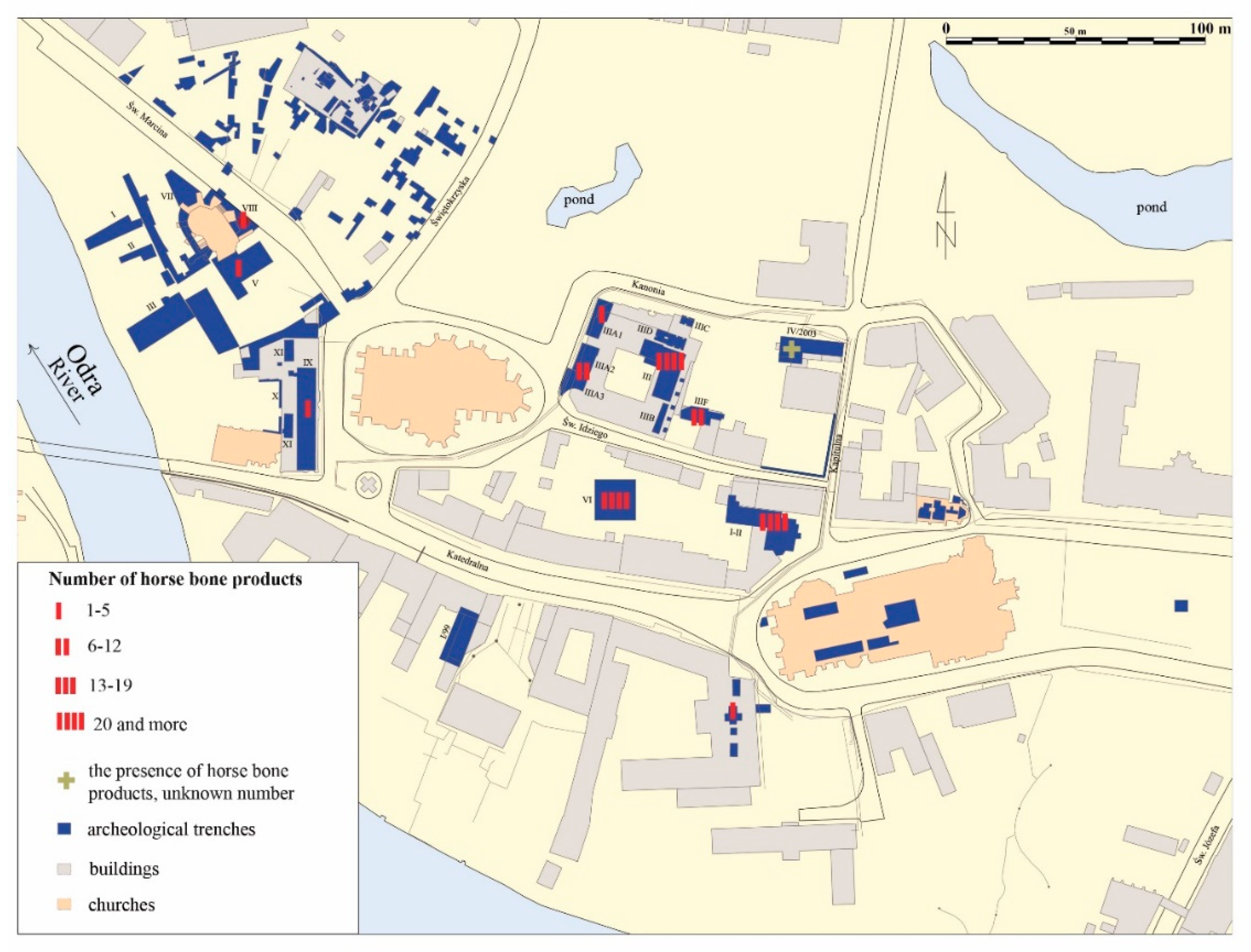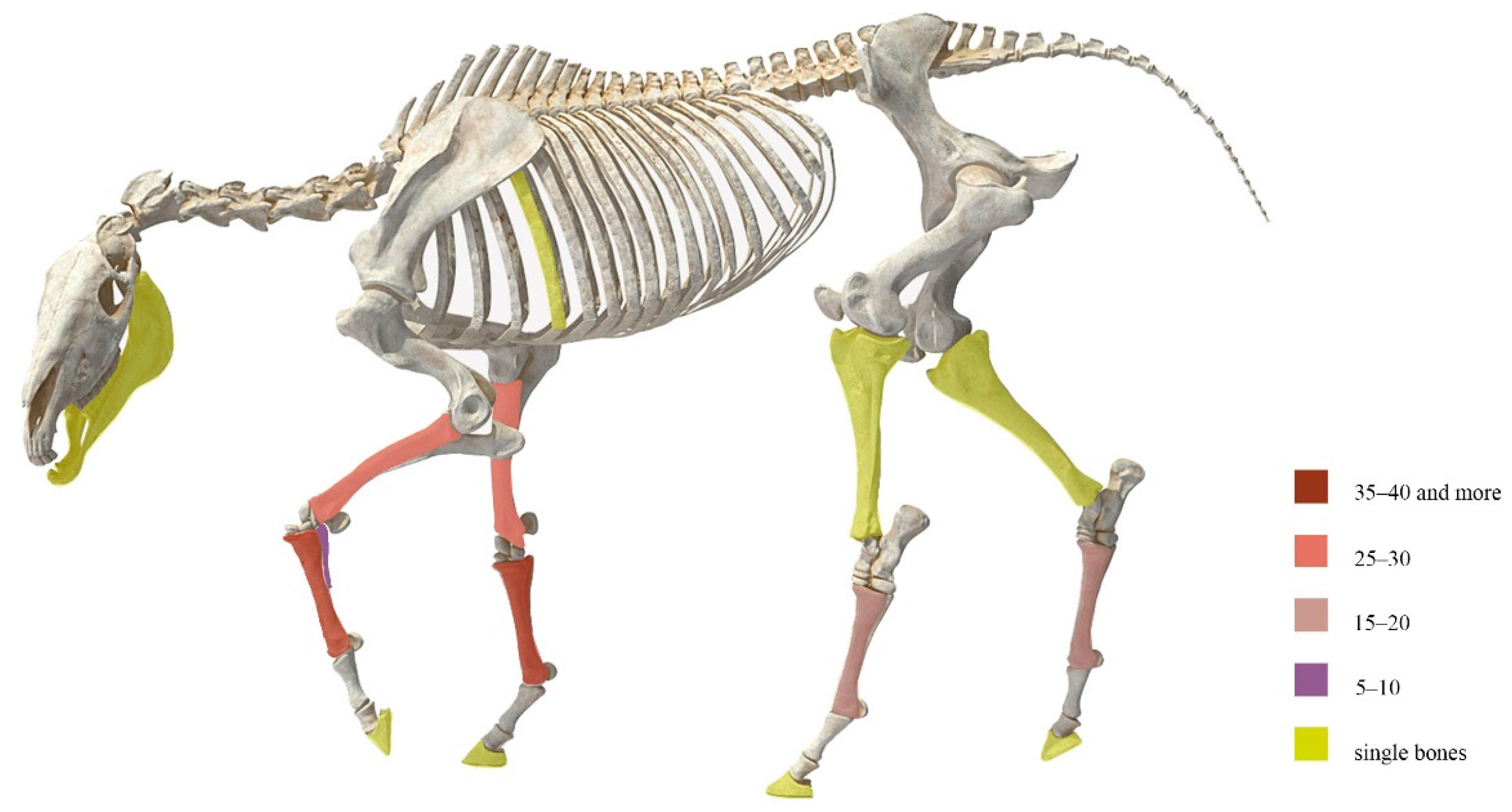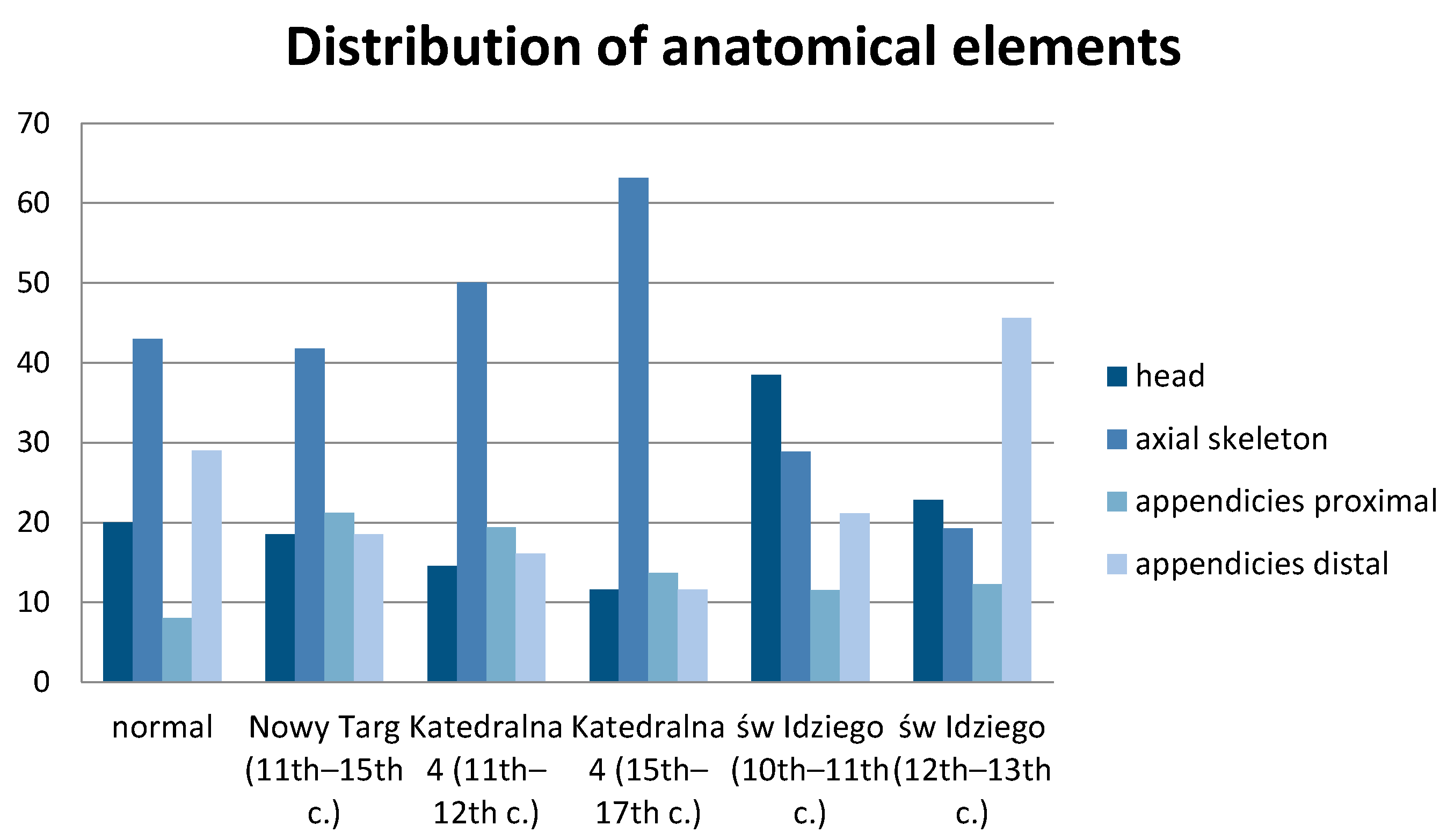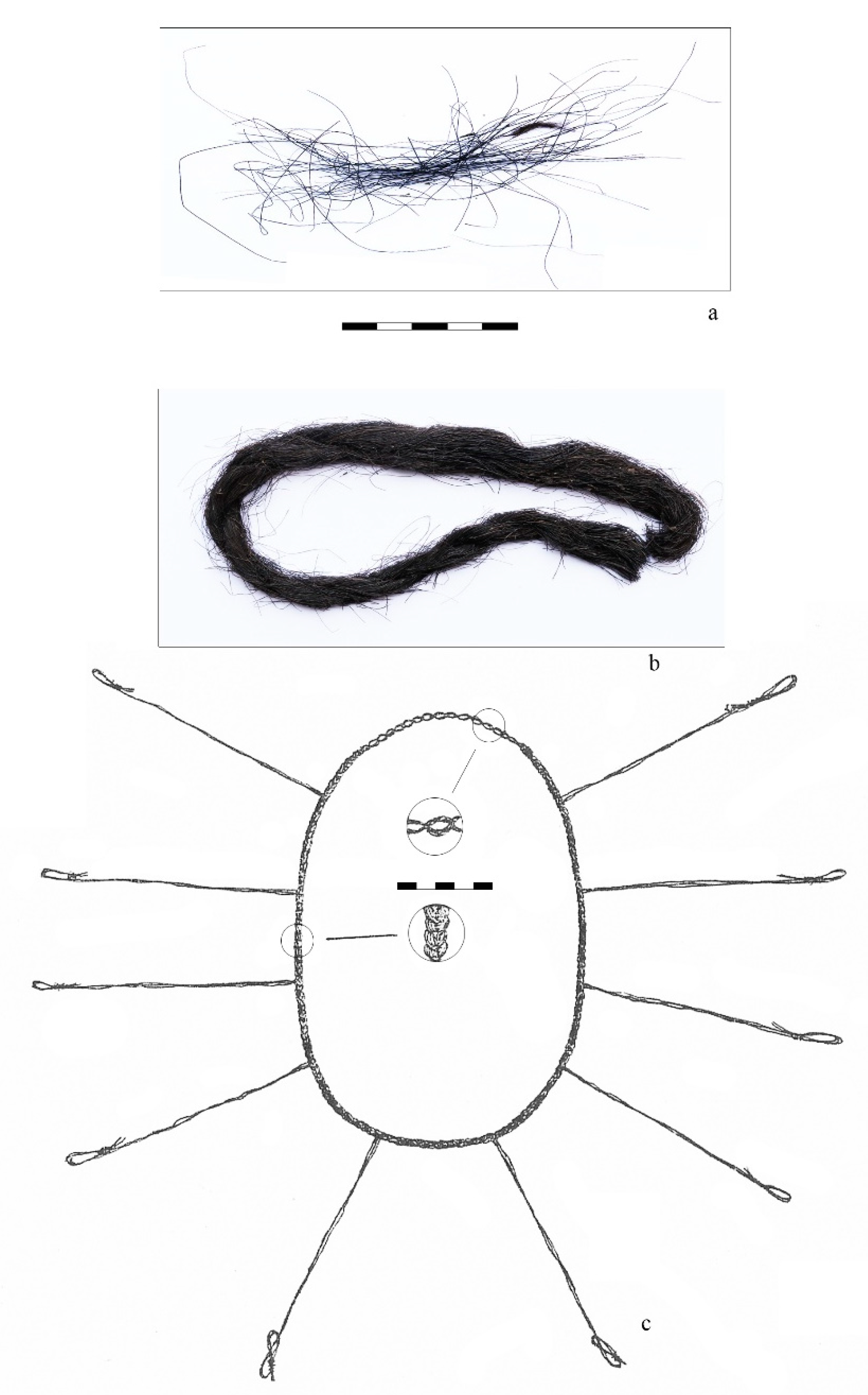Different Approach to Horses—The Use of Equid Remains in the Early Middle Ages on the Example of Ostrów Tumski in Wroclaw
Abstract
Simple Summary
Abstract
1. Introduction
2. Materials and Methods
3. Results and Discussion
3.1. Statistical Analysis of the Horse Skeletal Remains
3.2. Use of Horse Bones: Raw Material Preferences
3.3. Determining the Features of Wroclaw Horses Based on the Analysis of the Remains and Artefacts
- (a)
- small horses, 124.0–128.0 cm at the withers (15.5% of total number);
- (b)
- small horses among medium ones, 132.2–136.0 cm at the withers (31.1%);
- (c)
- medium horses, 136.4–144.0 cm at the withers (42.2%);
- (d)
- large horses among medium ones, 144.7–152.0 cm at the withers (11.1%).
3.4. Use of Other Horse-Based Raw Material
3.5. Horse Meat Consumption
4. Conclusions
Author Contributions
Funding
Conflicts of Interest
References
- Hyland, A. Equus. In The Medieval Warhorse. From Byzantium to the Crusades; Da Capo Press: Boston, UK, 1996. [Google Scholar]
- Dunlop, R.; Williams, D. Veterinary Medicine; Mosby: St. Louis, MO, USA, 1995. [Google Scholar]
- Hyland, A. The Horse in the Middle Ages; Sutton Publishing Ltd.: Stroud, UK, 1999. [Google Scholar]
- Baron, J. Ritual and cultural changes. Transformations in rituals at the junction of pagan religion and Christianity in early medieval Poland. In Rytm Przemian Kulturowych w Pradziejach i Średniowieczu, 1st ed.; Gediga, B., Grossman, A., Piotrowski, W., Eds.; Instytut Archeologii i Etnologii PAN: Biskupin-Wroclaw, Poland, 2012; pp. 449–464. [Google Scholar]
- Chrószcz, A.; Krupska, A.; Janeczek, M.; Pospieszny, N.; Jaworski, K.; Pankiewicz, A. Animal remains from the archaeological excavation at Gromnik Hill (Rummelsberg) in Poland. Acta Sci. Pol. 2011, 9, 19–32. [Google Scholar]
- Chrószcz, A.; Janeczek, M. Wstępna ocena szczątków kostnych ze stanowiska archeologicznego przy ulicy Katedralnej 4 na Ostrowie Tumskim we Wrocławiu. In Nowożytny Cmentarz Przy Kościele św. Piotra i Pawła na Ostrowie Tumskim we Wrocławiu (lata 1621–1670), 1st ed.; Pankiewicz, A., Ed.; Wratislavia Antiqua 17; Uniwersytet Wrocławski: Wrocław, Poland, 2012; pp. 205–222. [Google Scholar]
- Chrószcz, A.; Janeczek, M.; Poradowski, D.; Sudoł, B. Analiza archeozoologiczna szczątków kostnych z wykopu IIIF przy ulicy św. Idziego, na Ostrowie Tumskim we Wrocławiu. In Pago Silensi: Wrocławskie Studia Wczesnośredniowieczne, 1st ed.; Limisiewicz, A., Pankiewicz, A., Eds.; Uniwersytet Wrocławski: Wrocław, Poland, 2015; pp. 421–468. [Google Scholar]
- Chrószcz, A.; Janeczek, M.; Pasicka, E. Zwierzęta w średniowiecznym Wrocławiu. Problem struktury konsumpcji mięsa. In Rytm Rozwoju Miasta na Kulturowym Pograniczu Studium Strefy Nowy Targ We Wrocławiu, 1st ed.; Piekalski, J., Wachowski, K., Eds.; Wratislavia Antiqua 23; Uniwersytet Wrocławski: Wrocław, Poland, 2018; pp. 1083–1112. [Google Scholar]
- Daugnora, L.; Thomas, R. Horse burials from middle Lithuania: A palaeopathological investigation. In Diet and Health in Past Animal Populations: Current Research and Future Directions; Davies, J., Fabis, M., Mainland, I., Richards, M., Thomas, R., Eds.; Oxbow: Osford, UK, 2005; pp. 67–74. [Google Scholar]
- Stampfli, H.R. Die Tierreste von Wasenplatz und Richtstätte. In Richtstätte und Wasenplatz in Emmenbrücke (16–19. Jahrhundert). Archäologische und historische Untersuchungen zur Geschichte von Strafrechtspflege und Tierhaltung in Luzern. Schweizer Beiträge zur Kulturgeschichte und Archäologie des Mittelalters. In Schweizerische Burgenverein Olten und Freiburg, 1st ed.; Manser, J., Ed.; Walter Verlag: Base, Switzerland, 1992; pp. 157–177. [Google Scholar]
- Bartosiewicz, L.; Gal, E. Shuffling Nags, Lame Ducks: The Archaeology of Animal Disease; Oxbow Books: Barnsley, UK, 2013. [Google Scholar]
- Lavine, M.A.; Whitwell, K.E.; Jeffcott, L.B. Abnormal thoracic vertebrae and the evolution of horse husbandry. Archaeofauna 2005, 14, 93–109. [Google Scholar]
- Janeczek, M.; Chrószcz, A.; Onar, V.; Henklewski, R.; Piekalski, J.; Duma, P.; Czerski, A.; Całkosiński, I. Anatomical and biomechanical aspects of the horse spine: The interpretation of vertebral fusion in a medival horse from Wroclaw (Poland). Int. J. Osteoarchaeol. 2014, 24, 623–633. [Google Scholar] [CrossRef]
- Baxter, I.L. Species identification of equide from Western European archaeological deposits: Methodologies, techniques and problem. In Current and Recent Research in Osteoarchaeology; Anderson, S., Boyle, K., Eds.; Oxbow Books: Oxford, UK, 1998; pp. 3–17. [Google Scholar]
- Bendrey, R.; Thorpe, N.; Outram, A.; van Wijngaarden-Bakker, L.H. The origins of domestic horses in north-west Europe: New direct dates on the horses of Newgrange, Ireland. Proc. Prehist. Soc. 2013, 79, 1–13. [Google Scholar] [CrossRef]
- Bendrey, R. From wild horses to domestic horses: A European perspective. World Archaeol. 2012, 44, 135–157. [Google Scholar] [CrossRef]
- Makowiecki, D. Archaeozoology’s contribution to the improvement of historians’ conceptions of subsistence economy and environment in Early Medieval Poland—Selected problems. Beitrage zur Archäozoologie und Prähistorischen Anthropologie 2006, 5, 77–82. [Google Scholar]
- Sahnouni, M.; Rosell, J.; van der Made, J.; Vegas, J.M.; Olle, A.; Kandi, N.; Harichane, Z.; Derradij, A.; Medig, M. The first evidence of cut marks and usewear traces from the Plio-Pleistocene locality of El-Kherba (Ain Hanech, Algeria: Implications for early hominin subsistence activities circa 1.8 Ma. J. Hum. Evol. 2013, 64, 137–150. [Google Scholar] [CrossRef]
- Miller, W.I. Of Outlaws, Christians, Horsemeat and Writing: Uniform and Saga Iceland. Mich. Law Rev. 2016, 89, 2081–2095. [Google Scholar] [CrossRef][Green Version]
- Gieysztor, A. Mitologia Słowian; WUW: Warszawa, Poland, 2006. [Google Scholar]
- Pawshe, M.D.; Badhe, S.R.; Khedkar, C.D.; Pawshe, R.D.; Pundkar, A.Y. Horse Meat. In The Encyclopedia of Food and Health; Caballero, B., Finglas, P., Toldrá, F., Eds.; Academic Press: Oxford, UK, 2016; Volume 3, pp. 353–356. [Google Scholar]
- Beech, M. A matter of taste? Some evidence for the butchery of horses, dogs and bears et the La Tène Sttlement of Jenišův Újezd. In Archeologické Výzkumy v Severozápdnych Čechách v Letech 1983–1992; Blažek, J., Meduna, P., Eds.; Ústav Archeologické Památkove Péče Severozápdnych Čech: Most, Czech Republic, 1995; pp. 165–170. [Google Scholar]
- Foster, J. A Zooarchaeological Study of Changing Meat Supply and Butchery Practices at Medieval Castles in England. Ph.D. Thesis, University of Exeter, Exeter, UK, 2016. [Google Scholar]
- Wilson, B.; Edwards, P. Butchery of horse and dog at Witney Palace, Oxfordshire, and the knackering and feeding of meat to hounds during the post-medieval period. Post-Mediev. Archaeol. 1993, 27, 43–56. [Google Scholar] [CrossRef]
- Jaworski, K. Wyroby z Kości i Poroża w Kulturze Wczesnośredniowiecznego Ostrowa Tumskiego we Wrocławiu, 1st ed.; Volumen: Wrocław-Warszawa, Poland, 1990; pp. 7–23. [Google Scholar]
- Jaworski, K. Wytwórczość i Użytkowanie Wyrobów z Kości i Poroża na Wrocławskim Ostrowie Tumskim w X-XV Wieku. Ph.D. Thesis, University of Wroclaw, Wroclaw, Poland, 1993; pp. 41–270. [Google Scholar]
- Jaworski, K. Obróbka surowca kościanego w średniowieczu i czasach nowożytnych w zachodniej części Ostrowa Tumskiego we Wrocławiu. Materiały z posesji przy ul. Katedralnej 4. Wratislav. Antiq. 2012, 17, 165–204. [Google Scholar]
- Jaworski, K. Wczesnośredniowieczne wyroby z kości i poroża w centralnej części wrocławskiego Ostrowa Tumskiego w świetle badań wykopu IIIF i sąsiednich. In Pago Silensi: Wrocławskie Studia Wczesnośredniowieczne, 1st ed.; Limisiewicz, A., Pankiewicz, A., Eds.; Uniwersytet Wrocławski: Wrocław, Poland, 2015; pp. 229–259. [Google Scholar]
- Chrzanowska, W. Szczątki kostne zwierząt z wczesnośredniowiecznego stanowiska we Wrocławiu na Ostrowie Tumskim. Archeozoologia 1986, 11, 19–43. [Google Scholar]
- Romanow, M. Szczątki kostnie zwierząt z ulicy Kapitulnej 4 we Wrocławiu. Śląskie Sprawozdania Archeologiczne 2005, 47, 207–216. [Google Scholar]
- Myczkowski, K. Ogólne wyniki badań szczątków kostnych i skorup zwierzęcych z wczesnego średniowiecza, wydobytych na Ostrowie Tumskim we Wrocławiu w latach 1950–1957. Przegląd Archeologiczny 1960, 12, 150–171. [Google Scholar]
- Konczewska, M.; Radek, T. Przedmioty skórzane z Ostrowa Tumskiego we Wrocławiu. In Pago Silensi: Wrocławskie Studia Wczesnośredniowieczne, 1st ed.; Limisiewicz, A., Pankiewicz, A., Eds.; Uniwersytet Wrocławski: Wrocław, Poland, 2015; pp. 404–409. [Google Scholar]
- Kavánová, B. Knochen- und Geweihindustrie in Mikulčice. In Studien zum Burgwall von Mikulčice, Band 1; Daim, F., Poláček, L., Eds.; Archeologický Ústav AV ČR: Brno, Czech Republic, 1995; p. 259276. [Google Scholar]
- Norska-Gulkowa, M. Wyroby z kości i rogu z wczesnośredniowiecznego grodu-miasta na Ostrówku w Opolu. Opolski Rocznik Muzealny 1985, 8, 221–308. [Google Scholar]
- Jaworski, K. Wytwórczość rogownicza we Wrocławiu przed i po XIII-wiecznym przełomie. In Kultura Średniowiecznego Śląska i Czech: “Rewolucja”, wieku, XIII; Wachowski, K., Ed.; Uniwersytet Wrocławski: Wrocław, Poland, 1998; pp. 73–86. [Google Scholar]
- Thurber, B.A. Skates Made of Bone: A History, 1st ed.; McFarland & Company: Jefferson, NC, USA, 2020; p. 3655. [Google Scholar]
- Cyngot, D. Ewolucja łyżew—Od form kościanych do żelaznych, Materiały Zachodniopomorskie. Nowa Seria 2017, 13, 191–224. [Google Scholar]
- Wywrot-Wyszkowska, B.; Bone, A.; Artefacts, H. Wolin. The Old Town II. Studies on Finds; Rębkowski, M., Ed.; Instytut Archeologii i Etnologii PAN: Szczecin, Poland, 2019; pp. 137–190. [Google Scholar]
- Zamelska-Monczak, K. Przedmioty z kości i poroża oraz z metali. In Santok Strażnica i Klucz Królestwa Polskiego. Wyniki Badań z lat 1958–1965; Zamelska-Monczak, K., Ed.; Instytut Archeologii i Etnologii PAN: Warszawa, Poland, 2019; pp. 191–224. [Google Scholar]
- Lasota-Moskalewska, A. Zwierzęta Udomowione w Dziejach Ludzkości, 1st ed.; Wydawnictwo Uniwersytetu Warszawskiego: Warszawa, Poland, 2005; pp. 197–211. [Google Scholar]
- Makowiecki, D. Wyroby z kości i poroża w ujęciu zoologicznym. In Przedmioty z Poroża i Kości z Janowa Pomorskiego; Cnotliwy, E., Ed.; Muzeum Archeologiczno-Historyczne; Instytut Archeologii i Etnologii PAN: Elbląg, Poland, 2013; pp. 182–206. [Google Scholar]
- König, H.E.; Liebich, H.G. Anatomia Zwierząt Domowych. Kolorowy Atlas i Podręcznik; Galaktyka: Łódź, Poland, 2010. [Google Scholar]
- Lentz, J. Nie Wyrzucaj Odpadków; Towarzystwo Wydawnicze “Bluszcz”: Warszawa, Poland, 1929; pp. 8–37. [Google Scholar]
- Chrószcz, A.; Janeczek, M.; Pasicka, E.; Klećkowska-Nawrot, J. Heigth at the withers estimation in the horses based on the internal dimension of cranial cavity. Folia Morphol. 2014, 73, 143–148. [Google Scholar] [CrossRef] [PubMed]
- Wyrost, P.; Chrzanowska, W.; Molenda, O. Pferdeknochenreste aus den Frühmittelalterlichen Siedlungen Schlesiens. Archaeozoology; Agricultural Academy: Szczecin, Poland, 1979; pp. 439–459. [Google Scholar]
- Makowiecki, D. Zwierzęta Średniowiecznego i Nowożytnego Poznania Oraz Okolic: Podstawy Archeozoologiczne, 1st ed.; Bogucki Wydawnictwo Naukowe: Poznań, Poland, 2016; pp. 128, 140–142. [Google Scholar]
- Osypińska, M. Gospodarka zwierzętami we wczesnośredniowiecznym Santoku. Studium archeozoologiczne. In Santok Strażnica i Klucz Królestwa Polskiego. Wyniki Badań z lat 1958–1965; Zamelska-Monczak, K., Ed.; Instytut Archeologii i Etnologii PAN: Warszawa, Poland, 2019; pp. 325–346. [Google Scholar]
- Chrzanowska, W.; Krupska, A. Pferdeknochen aus dem frühmittelalterlichen Burgwall von Mikulčice Exkurs: Archäozoologische Analyse der Pferdebestattungen aus Mikulčice und Břeclav—Pohansko. In Studien zum Burgwall von Mikulčice. Band 5; Poláček, L., Ed.; Archeologický Ústav AV ČR: Brno, Czech Republic, 2003; pp. 151–214. [Google Scholar]
- Kaźmierczyk, J. Podkowy na Śląsku w X-XIV w. Studia z Dziejów Kultury Materialnej, 1st ed.; Ossolineum: Wrocław, Poland, 1978; pp. 153–162. [Google Scholar]
- Samsonowicz, A. Wytwórczość Skórzana w Polsce Wczesnofeudalnej, 1st ed.; Ossolineum: Wrocław, Poland, 1982; pp. 53–112. [Google Scholar]
- Radek, T. Analiza submikroskopowa surowca skórzanego ze średniowiecznego Kołobrzegu. Archeologia Kołobrzegu 1997, 2, 207–220. [Google Scholar]
- Kowalska, A.B. Wytwórczość Skórzana We Wczesnośredniowiecznym Szczecinie; Instytut Archeologii i Etnologii PAN: Szczecin, Poland, 2010; pp. 36–121. [Google Scholar]
- Lasota-Moskalewska, A. Postawy Archeozoologii. Szczątki Ssaków; Wydawnictwo Naukowe PWN: Warszawa, Poland, 1997. [Google Scholar]
- Bazarsad, B.; Yves, D.; Dorj, E. A Study of the Diameter Distribution and Tensile Property of Horse Tail Hair. J. Nat. Fibers 2008, 4, 1–11. [Google Scholar]
- Kaźmierczyk, J.; Kramarek, J.; Lasota, C. Badania na Ostrowie Tumskim we Wrocławiu w 1978 roku. Sil. Antiq. 1980, 22, 71–158. [Google Scholar]
- Kaźmierczyk, J. Ku Początkom Wrocławia. Cz. 2. Warsztat Budowlany i Kultura Mieszkalna Ostrowa Tumskiego od Połowy XI do Połowy XIII Wieku, 1st ed.; Volumen: Wrocław, Poland, 1993; pp. 166–167. [Google Scholar]
- Kaźmierczyk, J.; Kramarek, J.; Lasota, C. Badania na Ostrowie Tumskim we Wrocławiu w 1978 roku. Sil. Antiq. 1978, 20, 123–167. [Google Scholar]
- Sztych, D. Zastosowanie środków leczniczych pochodzenia zwierzęcego w medycynie ludowej. Życie Weterynaryjne 2013, 88, 126–132. [Google Scholar]
- Schulz, A. Essen und Trinken im Mittelalter (1000–1300). Literarische, Kunsthistorische und Archäologische Qellen, 1st ed.; De Gruyter: Berlin, Germany, 2011; pp. 422–423. [Google Scholar]






| Trench | TNF | NISP | Horse |
|---|---|---|---|
| I-II | 24,086 | 17,600 (73.07% TNF) | 651 (3.7% NISP) |
| III | 29,278 | 20,244 (69.14% TNF) | 618 (1.9% NISP) |
| III F | 15,420 | 8371 (54% TNF) | 111 (1.31% NISP) |
| IX | 2787 | 19,59 (70.3% TNF) | 62 (3.11% NISP) |
Publisher’s Note: MDPI stays neutral with regard to jurisdictional claims in published maps and institutional affiliations. |
© 2020 by the authors. Licensee MDPI, Basel, Switzerland. This article is an open access article distributed under the terms and conditions of the Creative Commons Attribution (CC BY) license (http://creativecommons.org/licenses/by/4.0/).
Share and Cite
Jaworski, K.; Pankiewicz, A.; Chrószcz, A.; Poradowski, D. Different Approach to Horses—The Use of Equid Remains in the Early Middle Ages on the Example of Ostrów Tumski in Wroclaw. Animals 2020, 10, 2294. https://doi.org/10.3390/ani10122294
Jaworski K, Pankiewicz A, Chrószcz A, Poradowski D. Different Approach to Horses—The Use of Equid Remains in the Early Middle Ages on the Example of Ostrów Tumski in Wroclaw. Animals. 2020; 10(12):2294. https://doi.org/10.3390/ani10122294
Chicago/Turabian StyleJaworski, Krzysztof, Aleksandra Pankiewicz, Aleksander Chrószcz, and Dominik Poradowski. 2020. "Different Approach to Horses—The Use of Equid Remains in the Early Middle Ages on the Example of Ostrów Tumski in Wroclaw" Animals 10, no. 12: 2294. https://doi.org/10.3390/ani10122294
APA StyleJaworski, K., Pankiewicz, A., Chrószcz, A., & Poradowski, D. (2020). Different Approach to Horses—The Use of Equid Remains in the Early Middle Ages on the Example of Ostrów Tumski in Wroclaw. Animals, 10(12), 2294. https://doi.org/10.3390/ani10122294





